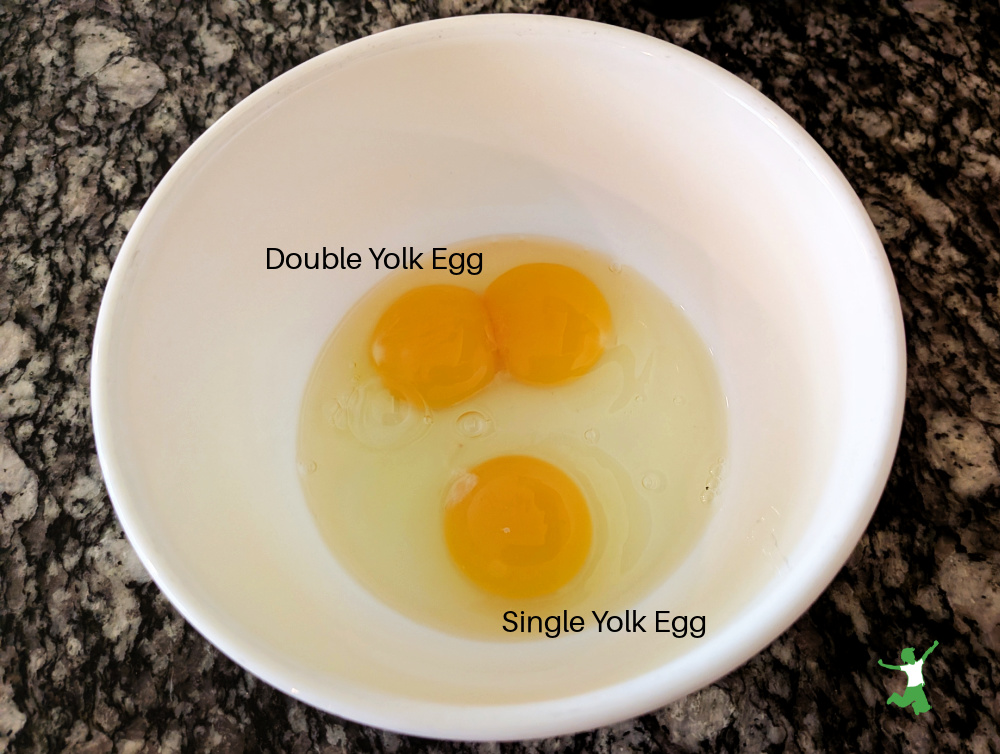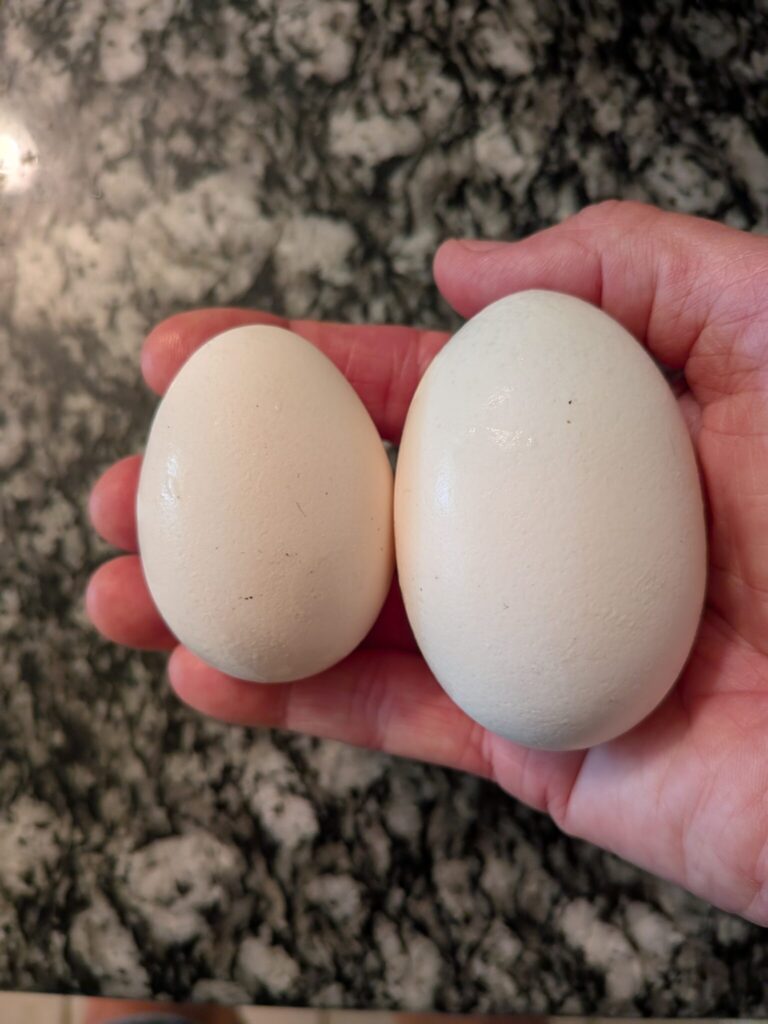The amazing phenomenon of double yolk eggs, how they compare to single yolk store eggs, and tips on getting more of these beauties from your hens!

One of the biggest benefits of keeping backyard chickens is that you get to enjoy eggs that you would rarely (if ever) come across buying organic store eggs.
Eggs you generally don’t see in cartons from the store are what’s called “double yolkers”. They are roughly the size of duck eggs!
Another example is eggs with “meat spots”.
Below is a picture of a double yolk egg that one of my newly laying White Leghorn hens gifted us recently.
Note the size of the double yolker compared to a single yolk egg.
These two eggs were laid by the same young hen!
I really hit the jackpot with this sweet bird ❤️
As you can see from the picture above, each yolk in the double egg is roughly the same size as the yolk in the single egg.
Since the yolk is the most nutritious part of an egg (can you believe some folks still throw them out?), you really do get “two for the price of one”.

While I am fortunate to have a hen that is only six months old laying double yolkers, these beauties typically come from older hens.
This is why you don’t see double yolk eggs in the store from industrialized farms even if organically certified.
Hens from mass production farms are normally culled for meat after only a year or so….as soon as their egg production starts to drop or their first molt, whichever comes first, according to what I’ve been told by those in the industry.
The commercial egg industry also prefers eggs from young hens (under a year and a half old) as this ensures uniformity of size for packing/shipping in egg cartons.
Eggs get larger in size with the age of the hen in my experience. Hence, the propensity for double yolk eggs from older birds.
If you’ve never seen double yolk eggs before, why not?
Are you still supporting the industrial food complex by purchasing eggs at the store?
Note that store eggs, even if organic, may be weeks old (or months old if partially frozen in storage) by the time you buy them. In addition, they are washed with undesirable chemicals as this is required in the United States.
Because eggshells are porous, some of this is no doubt getting into the eggs!
Read more details about the scam of organic store eggs and organic egg washing practices at the provided links.
Contrary to popular belief, a nutritious egg is not all about the yolk color, because this can easily be manipulated with feed to fool the consumer if the hens aren’t truly pastured.
I recommend getting your eggs from one of the sources below to ensure legit yolk color and to avoid the toxic practices that are allowed under USDA Organic for mass production facilities.
- Your own backyard coop (best)
- A neighbor
- Farmer’s market
- Independently owned health food stores that source from local egg farms.
You don’t need any double blind studies to see and taste the difference.
Your five senses will do just fine, thank you!








Hi Candace, fertilized eggs have this happen from time to time. No worries .. it cooks up and is very tasty. I’ve had these myself in the past.
Those would be nice to get my hands on since my little ones can only eat the yolks! I will say that pastured eggs in our area are still more expensive than even organic or free range eggs from the store…by more than a dollar. Guess I just need to keep looking!
If you get a lot of double yolks, that makes the higher price more reasonable as you are getting far more egg for your dollar. Just a thought.
One of the things I’ve noticed about the pastured eggs I buy, beyond the beautiful orange color, is how large the yolk is relative to the entire egg. They are the only eggs I would ever eat raw. I can’t imagine ever going back to eating eggs from the supermarket.
Sarah,
I hard-boiled a dozen of the eggs we got on Tuesday. Three of them, so far, have turned out to be double yolkers. It was a fun surprise to eat into the egg and find the two balls of yolk. My two year old didn’t blink twice but the rest of us knew it was quite a sight to see! I had been just telling the kids and hubby about these eggs and then voila I got your daily blog and shared it with the family.
Cheers,
Andrea
We just acquired 6 chickens from a lady who had 15 she had pastured (her dogs decided to start killing them so she gave the final 6 away, a blessing to us as we have been tossing around the idea of getting chickens for several months.) We’ve had them for one week and so far had one double yolker.
I love watching them roam around the yard and woods on our 5 acres.
Sarah – you mentioned shell hardness – do you know if it is true that you need to give chickens oyster shells (or feed containing such) to keep their shells hard/so they won’t peck them? (i’ve heard both stories).
Our birds thus far are not eating much of the feed we have in their house because they spend most of the day outside their pen. (Even when they are in their pen it is roughly 75×50 so there is plenty to sractch.)
Hi Danielle, I am no expert on raising layers by any means. I am more of an expert on eating them and identifying a good quality egg! LOL. That being said, most of the producers I’ve worked with over the years have given their chickens some sort of fish meal to add calcium and other minerals which does strengthen the shell considerably. There may be other ways, but I am not familiar with all the ins and outs.
We recycle our egg shells right back to the chickens. They will peck at the shells with the other vegetable scraps we give them. The calcium from the shell goes right back into the chicken.
Sarah, I cracked an egg this morning that was filled w/bright red blood. Any idea what causes this? Not exactly the most appetizing experience; but it is, after all, nature we’re dealing w/here!
Double yolks are nice – but that picture!!!!!! The yolks are sooooooo pale!!!!! Your farmer may have double yolk layers in production but his hens are not eating enough salad – pale yellow yolks. I raise chickens and ducks and try for nearly year round pasture so the chickens are health and so are their eggs. The orange pigmentation of the yolk signifies quality and nutrition – pale yellow indicate lack of green feed and come from hens who eat mostly corn and soy based feeds without clover and bugs and the benefits of the great outdoors…..
Happy egg eating….
w
Well, the shells are nice and hard and I’ve found the hardness of the shell to be a better indicator of nutrition than the yolk color. Orange is nice but I’ve come across more than one producer who plays games by putting beta carotene in the feed which turns the yolks orange. I find no problem with these yolks due to the hardness of the shell.
Just because you can artificially make a less-nutritious yolk look orange, it doesn’t necessarily follow that a really nutritious one can be pale. How did you decide that shell hardness = high nutrient content? Are you somehow measuring the nutrients in the hard-shelled eggs that you eat?
Different breeds of chickens can eat exactly the same diet and produce eggs with the same color yolks and drastically different shell thicknesses. If the chicken doesn’t get enough calcium, shell quality can suffer without necessarily affecting other nutritional qualities. Also, many chickens’ egg laying cycle is just a little longer than 24 hours – the same hen may lay an egg in the morning one day, at noon the next, and late afternoon the next, then skip a day and lay one with a very thick shell the following morning. Similarly, some hens that are just starting to lay may lay their eggs in the middle of the night, resulting in an egg with no shell, or just the very beginning of a shell at one end. The”guts” of that egg are identical to one that isn’t laid early, the bird’s body just hasn’t quite worked out its timing yet.
The yolks from the eggs I’m referring to are not pale. They are a deep yellow to orange color. Hard shelled eggs are more nutritious and hard shells can’t be faked like yolk color can. I live on a lake and we occasionally get eggs from the wild ducks that live there (they eat mostly fish and poke around for bugs on our back yard. The shells of those wild duck eggs are so hard they are practically porcelein.
Generally, a weak shell is a sign of low calcium intake. I can always tell whether our flock needs oyster shell based upon shell thickness. I wouldn’t think that would have much to do with the nutrient content of the egg itself, though, as usually we seek out eggs for fat soluble vitamins (well…and general yumminess, of course 🙂 ). In our flock, though, the alpha bird will steal oyster shell from the poor lowest in pecking order, so she inevitably produces thin-shelled eggs, and there’s not much we can do about it without caging her.
My customers tell me that while my eggs are a bit smaller in actual size than grocery store eggs, the yolks are 1/3 larger in comparison to store eggs. Free-range, non-GMO feed with added organic fishmeal. The flavor is incredible, too.
I love farm fresh eggs! There is no comparison to store bought eggs. We’re hoping to start raising our own laying chickens this year and I can’t wait.
The cholesterol in eggs is the kind that is healthy for you .. it is the oxidized cholesterol in processed foods that will gunk up your arteries. Eggs have long been absolved of contributing to any heart disease problems. I’ve written about this on the blog before. Eat those egg yolks with abandon, that’s where the most nutrition is!